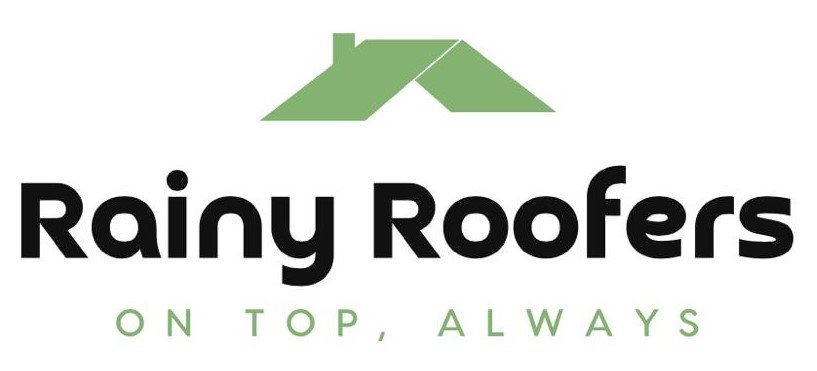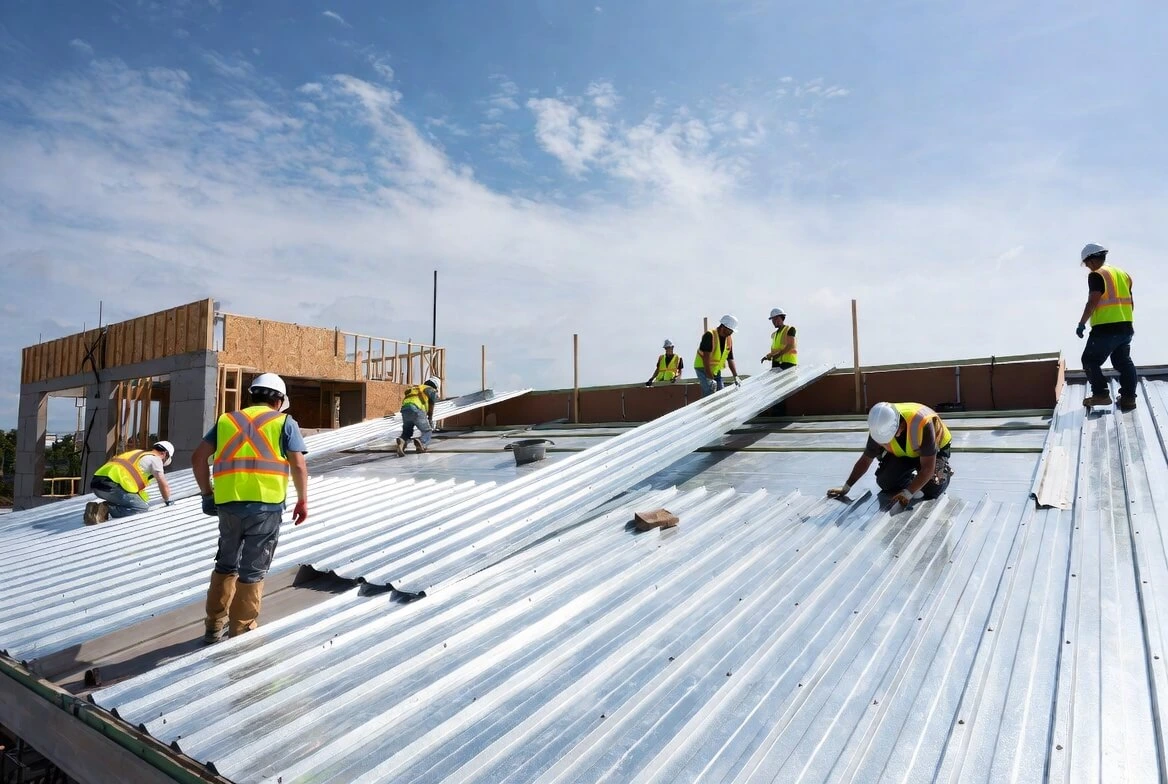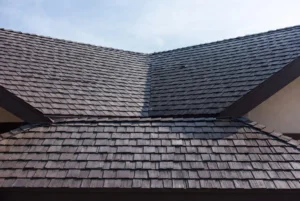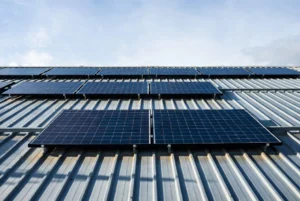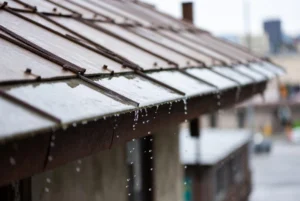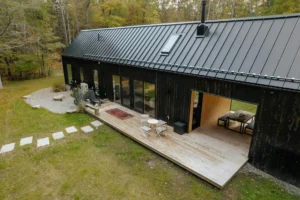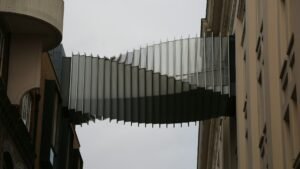Roof decking is the one thing nobody thinks about until a contractor says “your decking’s shot” and adds $8,000 to your quote. I learned this the hard way during my first roof replacement. I thought I was paying $14,200 for new shingles. Ended up at $22,600 because my roof sheathing looked like Swiss cheese.
The contractor pulled back one shingle and I saw daylight through 300+ nail holes. That’s when I got educated real fast about what’s under your roof.
What Is Roof Decking and Why Should You Care
Roof decking (also called roof sheathing or OSB sheathing) is the wooden foundation your entire roof sits on. It’s the flat surface installed over your trusses and rafters.
Think of it like the floor of your roof. Your shingles, underlayment, and everything else gets nailed to this base layer.
Without solid decking, your roof literally has nothing to stand on. The structural support fails and you’re looking at catastrophic problems.
I watched a neighbor ignore rotten decking for two years. His roof started sagging between the rafters. By the time he fixed it, interior water damage added another $12,000 to the bill.
Types of Roof Decking: What’s Actually Under Your Shingles
Not all roof decking material is the same. What you have determines cost, lifespan, and replacement complexity.
Plywood Roof Decking
Plywood is made from thin wood veneer layers glued together. It’s been the standard for decades.
Plywood roof decking comes in multiple thicknesses: ⅜”, ½”, ⅝”, and ¾”. The thickness depends on how far apart your rafters are spaced.
CDX plywood is the most common grade. The “C-D Exposure 1” rating means it handles some moisture but isn’t designed for constant exposure.
I replaced my old plywood sheathing after 28 years. Some sheets were fine. Others crumbled when the crew tried removing nails.
OSB (Oriented Strand Board) Roof Decking
OSB is now the most popular roof decking material in the US. It’s made from wood strands and adhesive resins compressed into flat sheets.
Standard OSB roof decking is 7/16″ thick. It’s cheaper than plywood and just as strong when properly installed.
The debate between plywood vs OSB never ends. Both work. OSB costs less. Plywood handles moisture slightly better. Pick based on budget and availability.
Plank Roof Decking
Plank decking is the old-school method. Individual wooden boards (1×6 or 1×8) installed across rafters.
You’ll find plank roof decking mostly in homes built before 1950. It’s still used occasionally but rare in modern construction.
Replacing plank decking costs about three times more per square foot than sheet decking. If you have it and need major work, contractors often install OSB or plywood over the top.
Steel Roof Decking
Steel roof decking is primarily used in commercial buildings, not residential homes. It’s made from galvanized steel panels that span large distances.
Metal roof decking offers massive strength, fire resistance, and durability. You’ll see it on warehouses, shopping centers, and industrial buildings.
Types include ribbed decks, waffle decks, and solid decks. Each handles different load requirements.
I’ve never installed steel roof decking on a house. But if you’re building a commercial structure or need serious load-bearing capacity, it’s worth considering.
Tongue and Groove Roof Decking
Tongue and groove boards interlock along the edges. 2×6 tongue and groove roof decking creates a solid, attractive roof deck.
This style costs more but creates a finished look if you’re exposing the underside. Popular in vaulted ceiling designs.
When Should Roof Decking Be Replaced
Here’s the truth: you won’t know until the old roof comes off. Most roofing contractors can’t tell you the exact condition until they start the tear off.
Signs your decking needs replacement:
Sagging areas visible from the ground Soft or spongy spots when walking on roof Water stains on attic ceiling or wallsVisible mold or mildew in attic Daylight shining through roof boards Dark discoloration on wood Rot or decay around penetrations
I had 14 sheets replaced at my last job. The contractor estimated 6-8 based on attic inspection. Once they pulled shingles, they found more damaged decking around valleys and chimneys.
Every roof replacement drives 115-175 nail holes per 4×8 sheet. After 2-3 reroof cycles, that decking looks like Swiss cheese.
Homes from the 1960s-1980s often have 300-500 nail holes per sheet. At that point, the wood can’t hold new nails. Replacement isn’t optional.
How Much Does Roof Decking Cost
Roof decking cost depends on material type, how much needs replacing, and current wood prices.
General pricing (including labor and materials):
OSB sheathing: $3-$5 per square foot installed Plywood: $4-$7 per square foot installed Plank decking: $8-$15 per square foot installed Tongue and groove: $10-$18 per square foot installed
These are 2025 estimates. Wood prices fluctuate wildly. What cost $4/sqft last year might be $6/sqft today.
My 14-sheet replacement (448 square feet) cost $2,240 in materials and labor. That’s $5 per square foot for ½” CDX plywood.
If I’d had plank decking, that same area would’ve run $4,480-$6,720. The cost-effective move is often overlaying plank decking with OSB rather than full replacement.
Roof Decking Code Requirements You Need to Know
Building codes exist to keep your roof from collapsing. Understanding them protects you from contractors cutting corners.
Code R905.2.1 of the International Residential Code states: asphalt shingles must be fastened to solidly sheathed decks.
This means your decking must be structurally sound enough to hold your roofing materials. If it’s compromised, rotten, or unstable, it must be replaced.
The manufacturer’s installation instructions also carry code weight. If your plank decking has gaps over 1/8″ between boards, most shingle manufacturers require replacement or overlay before installation.
Some contractors undercut competitors by skipping this. They’ll install bad decking to win the bid at a lower price.
Always ask your contractor: “Will you check decking integrity and replace what’s needed per code?” Get it in writing.
The Hidden Benefits of Quality Roof Decking
Good decking does more than hold shingles. It’s a critical structural component with multiple functions.
What proper decking provides:
Distributes weight evenly across the roof framing Creates rigid platform for safe installation Acts as moisture barrier(when properly sealed) Improves energy efficiency through better insulation Prevents sagging and structural damageSupports snow loads and wind loads
My neighbor cheated out and kept damaged decking during his reroof. Two years later, his roof started sagging. Cost him $18,000 to fix properly.
I spent the extra $2,240 upfront. Seven years later, my roof is still perfectly flat with zero issues.
Plywood vs OSB: Which Roof Decking Material Wins
The eternal debate. Both work. Both have pros and cons.
Plywood advantages:
- Handles moisture slightly better
- Doesn’t swell as much when wet
- Easier to spot damage during inspection
OSB advantages:
- Cost-effective (20-30% cheaper)
- More consistent quality (no knots or weak spots)
- Better availability in most markets
I’ve used both. Honestly? The difference is minimal if installed properly with good underlayment and ventilation.
Pick based on budget and what your roofing contractor recommends for your specific situation.
What Causes Roof Decking to Rot
Moisture is the enemy. Keep water away from your decking and it’ll last 50+ years. Let water in and you’re replacing it in 10.
Common causes of decking rot:
Poor ventilation trapping moisture in attic Leaks around chimneys, valleys, or penetrations Ice dams forcing water under shingles Condensation from temperature differences Clogged gutters causing water backup Missing or damaged flashing
I see rotted decking most often around chimneys and in roof valleys. Water concentrates in these areas and exploits any weakness.
Regular inspection and maintenance prevents most rot. Catch small problems before they become expensive disasters.
Steel Roof Decking for Commercial Applications
Steel roof decking isn’t for houses. But if you’re building commercial space, it’s worth understanding.
Metal roof decking spans large distances without support. A steel deck can bridge 20-30 feet between structural beams.
Benefits of steel decking:
Fire resistance (non-combustible) Strength handling massive loads Durability lasting 50+ years Fast installation compared to wood No rot or moisture issues
Types of steel decking:
Ribbed decks with perpendicular reinforcement Waffle decks with multi-directional support Solid decks for maximum load capacity
I toured a warehouse during construction. They installed steel roof decking in two days over 40,000 square feet. Try doing that with plywood.
For residential work, stick with wood. For commercial buildings, steel roof decking makes perfect sense.
FAQs About Roof Decking
What is the roof decking?
Roof decking is the wooden or metal layer installed over roof rafters that provides a stable base for shingles and other roofing materials.
What is the best material for roof decking?
OSB (oriented strand board) and plywood are both excellent choices, with OSB being more cost-effective and plywood handling moisture slightly better.
What is the roofdeck?
A roof deck is the same as roof decking – the structural foundation layer that supports all roofing materials.
Is roof decking the same as plywood?
No, roof decking is the general term for the base layer, while plywood is one type of material used for roof decking.
Is roof decking waterproof?
No, roof decking is not waterproof on its own; it requires underlayment and proper roofing materials for water protection.
How to attach roof decking?
Roof decking is attached to rafters or trusses using roofing nails or screws spaced according to building code requirements.
What are the disadvantages of a roof deck?
The main disadvantages include susceptibility to moisture damage, rot if not properly ventilated, and the need for periodic replacement.
What is another name for roof decking?
Roof sheathing is the most common alternative name for roof decking.
Is roof decking expensive?
Roof decking costs $3-$7 per square foot installed for wood materials, making it a moderate expense during roof replacement.
What thickness is roof decking?
Standard roof decking thickness ranges from 7/16″ for OSB to ½”-¾” for plywood, depending on rafter spacing.
What are the different types of roof decking?
The main types are plywood, OSB (oriented strand board), plank decking, tongue and groove, and steel decking for commercial applications.
Is roof decking necessary?
Yes, roof decking is absolutely necessary as it provides the structural foundation that supports all roofing materials and distributes weight.
What is the best option for roof decking?
OSB sheathing offers the best balance of cost-effectiveness, strength, and availability for most residential roofing applications.
What is the disadvantage of a wooden roof?
Wooden roof decking is susceptible to rot, moisture damage, insect infestation, and requires replacement every 2-3 roof cycles.
What is the difference between a roof deck and a terrace?
A roof deck refers to the structural decking under roofing materials, while a terrace is an outdoor living space built on top of a flat roof.
The Bottom Line on Roof Decking
Roof decking is the foundation of your entire roof system. Ignore it and you’re gambling with structural failure, water damage, and massive repair bills.
Budget for potential replacement when planning your reroof. If your roof is 20+ years old, expect to replace at least some decking. Ask contractors about decking conditions during estimates. Get their assessment in writing. Make sure replacement is included if needed.
The extra $2,000-5,000 upfront saves you $15,000+ in problems later. I learned this lesson the expensive way. You don’t have to. Your roof decking protects everything else. Treat it that way.
Read more blogs at rainy roofers
Roof decking is the one thing nobody thinks about until a contractor says “your decking’s shot” and adds $8,000 to your quote. I learned this the hard way during my first roof replacement. I thought I was paying $14,200 for new shingles. Ended up at $22,600 because my roof sheathing looked like Swiss cheese.
The contractor pulled back one shingle and I saw daylight through 300+ nail holes. That’s when I got educated real fast about what’s under your roof.
What Is Roof Decking and Why Should You Care
Roof decking (also called roof sheathing or OSB sheathing) is the wooden foundation your entire roof sits on. It’s the flat surface installed over your trusses and rafters.
Think of it like the floor of your roof. Your shingles, underlayment, and everything else gets nailed to this base layer.
Without solid decking, your roof literally has nothing to stand on. The structural support fails and you’re looking at catastrophic problems.
I watched a neighbor ignore rotten decking for two years. His roof started sagging between the rafters. By the time he fixed it, interior water damage added another $12,000 to the bill.
Types of Roof Decking: What’s Actually Under Your Shingles
Not all roof decking material is the same. What you have determines cost, lifespan, and replacement complexity.
Plywood Roof Decking
Plywood is made from thin wood veneer layers glued together. It’s been the standard for decades.
Plywood roof decking comes in multiple thicknesses: ⅜”, ½”, ⅝”, and ¾”. The thickness depends on how far apart your rafters are spaced.
CDX plywood is the most common grade. The “C-D Exposure 1” rating means it handles some moisture but isn’t designed for constant exposure.
I replaced my old plywood sheathing after 28 years. Some sheets were fine. Others crumbled when the crew tried removing nails.
OSB (Oriented Strand Board) Roof Decking
OSB is now the most popular roof decking material in the US. It’s made from wood strands and adhesive resins compressed into flat sheets.
Standard OSB roof decking is 7/16″ thick. It’s cheaper than plywood and just as strong when properly installed.
The debate between plywood vs OSB never ends. Both work. OSB costs less. Plywood handles moisture slightly better. Pick based on budget and availability.
Plank Roof Decking
Plank decking is the old-school method. Individual wooden boards (1×6 or 1×8) installed across rafters.
You’ll find plank roof decking mostly in homes built before 1950. It’s still used occasionally but rare in modern construction.
Replacing plank decking costs about three times more per square foot than sheet decking. If you have it and need major work, contractors often install OSB or plywood over the top.
Steel Roof Decking
Steel roof decking is primarily used in commercial buildings, not residential homes. It’s made from galvanized steel panels that span large distances.
Metal roof decking offers massive strength, fire resistance, and durability. You’ll see it on warehouses, shopping centers, and industrial buildings.
Types include ribbed decks, waffle decks, and solid decks. Each handles different load requirements.
I’ve never installed steel roof decking on a house. But if you’re building a commercial structure or need serious load-bearing capacity, it’s worth considering.
Tongue and Groove Roof Decking
Tongue and groove boards interlock along the edges. 2×6 tongue and groove roof decking creates a solid, attractive roof deck.
This style costs more but creates a finished look if you’re exposing the underside. Popular in vaulted ceiling designs.
When Should Roof Decking Be Replaced
Here’s the truth: you won’t know until the old roof comes off. Most roofing contractors can’t tell you the exact condition until they start the tear off.
Signs your decking needs replacement:
Sagging areas visible from the ground Soft or spongy spots when walking on roof Water stains on attic ceiling or wallsVisible mold or mildew in attic Daylight shining through roof boards Dark discoloration on wood Rot or decay around penetrations
I had 14 sheets replaced at my last job. The contractor estimated 6-8 based on attic inspection. Once they pulled shingles, they found more damaged decking around valleys and chimneys.
Every roof replacement drives 115-175 nail holes per 4×8 sheet. After 2-3 reroof cycles, that decking looks like Swiss cheese.
Homes from the 1960s-1980s often have 300-500 nail holes per sheet. At that point, the wood can’t hold new nails. Replacement isn’t optional.
How Much Does Roof Decking Cost
Roof decking cost depends on material type, how much needs replacing, and current wood prices.
General pricing (including labor and materials):
OSB sheathing: $3-$5 per square foot installed Plywood: $4-$7 per square foot installed Plank decking: $8-$15 per square foot installed Tongue and groove: $10-$18 per square foot installed
These are 2025 estimates. Wood prices fluctuate wildly. What cost $4/sqft last year might be $6/sqft today.
My 14-sheet replacement (448 square feet) cost $2,240 in materials and labor. That’s $5 per square foot for ½” CDX plywood.
If I’d had plank decking, that same area would’ve run $4,480-$6,720. The cost-effective move is often overlaying plank decking with OSB rather than full replacement.
Roof Decking Code Requirements You Need to Know
Building codes exist to keep your roof from collapsing. Understanding them protects you from contractors cutting corners.
Code R905.2.1 of the International Residential Code states: asphalt shingles must be fastened to solidly sheathed decks.
This means your decking must be structurally sound enough to hold your roofing materials. If it’s compromised, rotten, or unstable, it must be replaced.
The manufacturer’s installation instructions also carry code weight. If your plank decking has gaps over 1/8″ between boards, most shingle manufacturers require replacement or overlay before installation.
Some contractors undercut competitors by skipping this. They’ll install bad decking to win the bid at a lower price.
Always ask your contractor: “Will you check decking integrity and replace what’s needed per code?” Get it in writing.
The Hidden Benefits of Quality Roof Decking
Good decking does more than hold shingles. It’s a critical structural component with multiple functions.
What proper decking provides:
Distributes weight evenly across the roof framing Creates rigid platform for safe installation Acts as moisture barrier(when properly sealed) Improves energy efficiency through better insulation Prevents sagging and structural damageSupports snow loads and wind loads
My neighbor cheated out and kept damaged decking during his reroof. Two years later, his roof started sagging. Cost him $18,000 to fix properly.
I spent the extra $2,240 upfront. Seven years later, my roof is still perfectly flat with zero issues.
Plywood vs OSB: Which Roof Decking Material Wins
The eternal debate. Both work. Both have pros and cons.
Plywood advantages:
- Handles moisture slightly better
- Doesn’t swell as much when wet
- Easier to spot damage during inspection
OSB advantages:
- Cost-effective (20-30% cheaper)
- More consistent quality (no knots or weak spots)
- Better availability in most markets
I’ve used both. Honestly? The difference is minimal if installed properly with good underlayment and ventilation.
Pick based on budget and what your roofing contractor recommends for your specific situation.
What Causes Roof Decking to Rot
Moisture is the enemy. Keep water away from your decking and it’ll last 50+ years. Let water in and you’re replacing it in 10.
Common causes of decking rot:
Poor ventilation trapping moisture in attic Leaks around chimneys, valleys, or penetrations Ice dams forcing water under shingles Condensation from temperature differences Clogged gutters causing water backup Missing or damaged flashing
I see rotted decking most often around chimneys and in roof valleys. Water concentrates in these areas and exploits any weakness.
Regular inspection and maintenance prevents most rot. Catch small problems before they become expensive disasters.
Steel Roof Decking for Commercial Applications
Steel roof decking isn’t for houses. But if you’re building commercial space, it’s worth understanding.
Metal roof decking spans large distances without support. A steel deck can bridge 20-30 feet between structural beams.
Benefits of steel decking:
Fire resistance (non-combustible) Strength handling massive loads Durability lasting 50+ years Fast installation compared to wood No rot or moisture issues
Types of steel decking:
Ribbed decks with perpendicular reinforcement Waffle decks with multi-directional support Solid decks for maximum load capacity
I toured a warehouse during construction. They installed steel roof decking in two days over 40,000 square feet. Try doing that with plywood.
For residential work, stick with wood. For commercial buildings, steel roof decking makes perfect sense.
FAQs About Roof Decking
What is the roof decking?
Roof decking is the wooden or metal layer installed over roof rafters that provides a stable base for shingles and other roofing materials.
What is the best material for roof decking?
OSB (oriented strand board) and plywood are both excellent choices, with OSB being more cost-effective and plywood handling moisture slightly better.
What is the roofdeck?
A roof deck is the same as roof decking – the structural foundation layer that supports all roofing materials.
Is roof decking the same as plywood?
No, roof decking is the general term for the base layer, while plywood is one type of material used for roof decking.
Is roof decking waterproof?
No, roof decking is not waterproof on its own; it requires underlayment and proper roofing materials for water protection.
How to attach roof decking?
Roof decking is attached to rafters or trusses using roofing nails or screws spaced according to building code requirements.
What are the disadvantages of a roof deck?
The main disadvantages include susceptibility to moisture damage, rot if not properly ventilated, and the need for periodic replacement.
What is another name for roof decking?
Roof sheathing is the most common alternative name for roof decking.
Is roof decking expensive?
Roof decking costs $3-$7 per square foot installed for wood materials, making it a moderate expense during roof replacement.
What thickness is roof decking?
Standard roof decking thickness ranges from 7/16″ for OSB to ½”-¾” for plywood, depending on rafter spacing.
What are the different types of roof decking?
The main types are plywood, OSB (oriented strand board), plank decking, tongue and groove, and steel decking for commercial applications.
Is roof decking necessary?
Yes, roof decking is absolutely necessary as it provides the structural foundation that supports all roofing materials and distributes weight.
What is the best option for roof decking?
OSB sheathing offers the best balance of cost-effectiveness, strength, and availability for most residential roofing applications.
What is the disadvantage of a wooden roof?
Wooden roof decking is susceptible to rot, moisture damage, insect infestation, and requires replacement every 2-3 roof cycles.
What is the difference between a roof deck and a terrace?
A roof deck refers to the structural decking under roofing materials, while a terrace is an outdoor living space built on top of a flat roof.
The Bottom Line on Roof Decking
Roof decking is the foundation of your entire roof system. Ignore it and you’re gambling with structural failure, water damage, and massive repair bills.
Budget for potential replacement when planning your reroof. If your roof is 20+ years old, expect to replace at least some decking. Ask contractors about decking conditions during estimates. Get their assessment in writing. Make sure replacement is included if needed.
The extra $2,000-5,000 upfront saves you $15,000+ in problems later. I learned this lesson the expensive way. You don’t have to. Your roof decking protects everything else. Treat it that way.
Read more blogs at Rainy Roofers.
